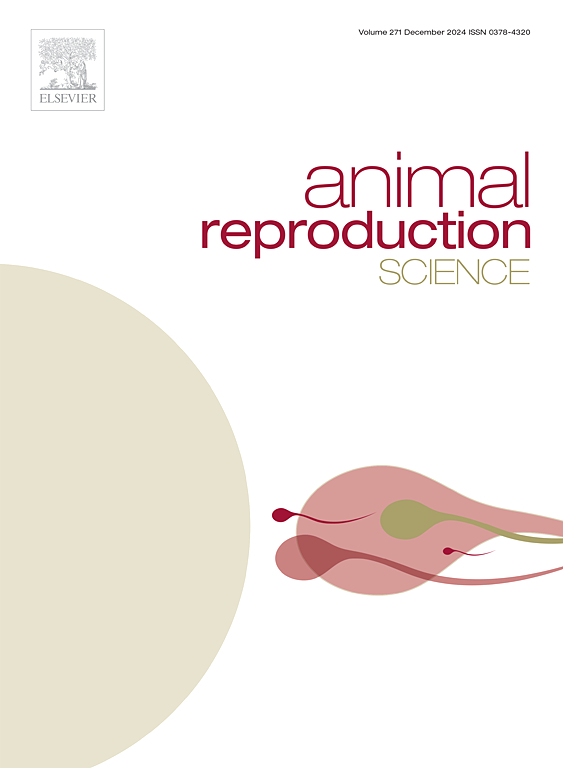Artificial insemination and optimization of the use of seminal doses in swine
IF 3.3
2区 农林科学
Q1 AGRICULTURE, DAIRY & ANIMAL SCIENCE
引用次数: 0
Abstract
The optimization of processes associated with artificial insemination (AI) is of great importance for the success of the pig industry. Over the last two decades, great reproductive performance has been achieved, making further significant progress limited. Optimizing the AI program, however, is essential to the pig industry's sustainability. Thus, the aim is not only to reduce the number of sperm cells used per estrous sow but also to improve some practical management in sow farms and boar studs to transform the high reproductive performance to a more efficient program. As productivity is mainly influenced by the number of inseminated sows, guaranteeing a constant breeding group and with healthy animals is paramount. In the AI studs, all management must ensure conditions to the health of the boars. Some strategies have been proposed and discussed to achieve these targets. A constant flow of high-quality and well-managed breeding groups, quality control of semen doses produced, more reliable technology in the laboratory routine, removal of less fertile boars, the use of intrauterine AI, the use of a single AI with control of estrus and ovulation (fixed-time AI), estrus detection based on artificial intelligence technologies, and optimization regarding the use of semen doses from high genetic-indexed boars are some strategies in which improvement is sought. In addition to these new approaches, we must revisit the processes used in boar studs, semen delivery network, and sow farm management for a more efficient AI program. This review discusses the challenges and opportunities in adopting some technologies to achieve satisfactory reproductive performance and efficiency.
猪的人工授精和精液剂量的优化使用。
人工授精(AI)相关流程的优化对养猪业的成功至关重要。在过去的二十年里,养猪业已经取得了巨大的繁殖成绩,但要取得更大的进步还很有限。然而,优化人工授精计划对养猪业的可持续发展至关重要。因此,我们的目标不仅是减少每头发情母猪使用的精子细胞数量,还要改善母猪场和公猪站的一些实际管理,将高繁殖性能转化为更高效的程序。由于生产率主要受受精母猪数量的影响,因此保证配种群的稳定和动物的健康至关重要。在人工授精种公猪场,所有管理人员都必须确保公猪的健康状况。为了实现这些目标,已经提出并讨论了一些策略。持续不断的高质量和管理良好的配种群、精液剂量的质量控制、更可靠的实验室常规技术、淘汰繁殖力较低的公猪、使用宫内人工授精、使用控制发情和排卵的单一人工授精(固定时间人工授精)、基于人工智能技术的发情检测,以及优化使用高遗传指数公猪的精液剂量,这些都是需要改进的策略。除了这些新方法外,我们还必须重新审视公猪站、精液输送网络和母猪场管理中使用的流程,以提高人工授精计划的效率。本综述讨论了采用某些技术以实现令人满意的繁殖性能和效率所面临的挑战和机遇。
本文章由计算机程序翻译,如有差异,请以英文原文为准。
求助全文
约1分钟内获得全文
求助全文
来源期刊

Animal Reproduction Science
农林科学-奶制品与动物科学
CiteScore
4.50
自引率
9.10%
发文量
136
审稿时长
54 days
期刊介绍:
Animal Reproduction Science publishes results from studies relating to reproduction and fertility in animals. This includes both fundamental research and applied studies, including management practices that increase our understanding of the biology and manipulation of reproduction. Manuscripts should go into depth in the mechanisms involved in the research reported, rather than a give a mere description of findings. The focus is on animals that are useful to humans including food- and fibre-producing; companion/recreational; captive; and endangered species including zoo animals, but excluding laboratory animals unless the results of the study provide new information that impacts the basic understanding of the biology or manipulation of reproduction.
The journal''s scope includes the study of reproductive physiology and endocrinology, reproductive cycles, natural and artificial control of reproduction, preservation and use of gametes and embryos, pregnancy and parturition, infertility and sterility, diagnostic and therapeutic techniques.
The Editorial Board of Animal Reproduction Science has decided not to publish papers in which there is an exclusive examination of the in vitro development of oocytes and embryos; however, there will be consideration of papers that include in vitro studies where the source of the oocytes and/or development of the embryos beyond the blastocyst stage is part of the experimental design.
 求助内容:
求助内容: 应助结果提醒方式:
应助结果提醒方式:


